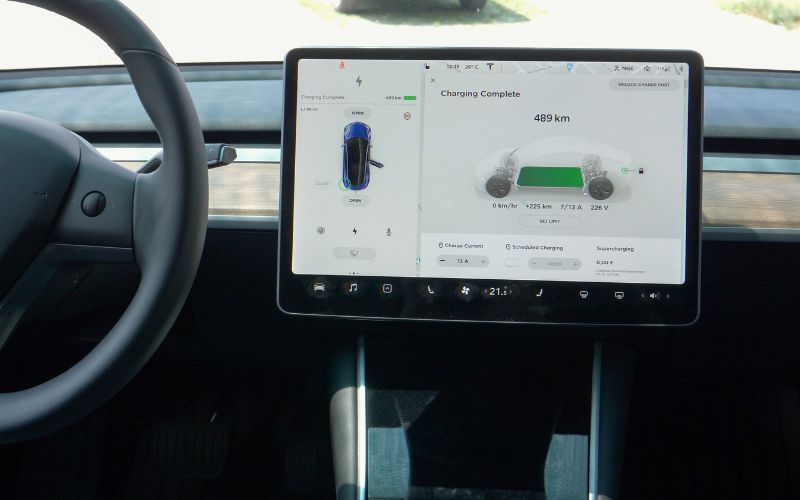Tesla Over-The-Air Updates: The Future Of Automotive Innovation!
Last updated on September 12th, 2023 at 03:04 am
Tesla car owners often receive over-the-air updates that enable electric cars to catch up on the latest software updates wirelessly.
With this feature, Tesla can improve its product’s performance, fix errors, and include new features without requiring visits to physical car servicing centers.
In this article, I’ll discuss the working process and overall efficiency of the Tesla over-the-air update.
The Tesla Over-the-Air (OTA) update sends software and firmware updates wirelessly over the internet to Tesla vehicles. With this unique feature, vehicle owners can receive new improvements without much cost. The OTA updates also play a role in ensuring Tesla vehicles are at top performance without requiring the services of physical servicing centers.
This article will explore the ins and outs of Tesla’s over-the-air updates and give detailed information on its cost and efficiency.
Does Tesla Have Over-The-Air Updates?

Yes, Tesla has over-the-air updates, which is one of its key, unique features.
With over-the-air (OTA) updates, Tesla can upgrade the vehicle’s software without requiring the owner to bring it to a service center.
Moreover, some of Tesla’s updates typically include error fixes, security updates, new specifications, and performance improvements.
Once Tesla releases new car updates through WiFi or cellular data, the vehicle’s onboard computer receives the update pending the owner’s permission.
However, with traditional car companies, car owners often need to visit a car dealership for updates or repairs.
This disadvantage gives Tesla vehicles an upper hand as this process can be time-consuming and inconvenient for car owners.
In addition, Tesla’s over-the-air updates also improve the vehicle’s battery management system, which increases the car’s drive range.
Tesla releases over-the-air updates periodically by announcing them through the vehicle’s infotainment system or the Tesla mobile app.
These improvements also mean that Tesla car owners can skip buying new vehicles for a while as drivers can keep upgrading their vehicles over time.
Besides improving the Tesla car’s performance and adding new upgrades, OTA updates address safety and security issues or recall notices.
Tesla updates are also famous for their speed and convenience. Unlike the usual car repairs at servicing centers, OTA updates save the time and costs of going through frequent fixes.
This benefit allows Tesla users to receive updates and bug fixes faster than mechanical cars waiting for physical upgrades and repairs.
Tesla users agree that Tesla’s over-the-air updates are also easy to access and user-friendly.
Once there is an available update, the driver can choose between updating the vehicle immediately or setting up the update for a later time.
After the car owner has installed the firmware, the update will commence automatically without requiring any manual process.
Since Tesla introduced the OTA update into the system, continuous upgrades have improved the system.
It ranges from implementing features like scheduled updates to the “Advanced” option that allows users access to features before they are available to the public.
These updates keep the Tesla vehicles at high performance, giving users a great riding experience without wasting time and costs on regular fixes.
When Did Tesla Start Over-The-Air Updates?
Tesla’s over-the-air (OTA) updates started in 2012 with the Model S, the first car that Tesla used to introduce the touch screen display.
With the new Tesla feature, Tesla drivers could receive repairs and upgrades from their homes or elsewhere at their convenience.
Since 2012, Tesla has continued to grow and refine its OTA upgrade functionalities till date.
Also, with each new Tesla model comes a newer update that improves the car’s performance, adds more features, and addresses any bugs in the system.
The Tesla over-the-air (OTA) update is a crucial feature that differentiates it from other motor companies due to its convenience and ease of use.
When Tesla launched the Model S, it was an automobile breakthrough due to its electric design and software technology.
The Tesla model included a large touchscreen display containing most of the car’s control functions, such as navigation and entertainment.
The Model S also included the Autopilot function, an advanced feature that allows the car to assist the user with driving tasks.
However, to ensure the continuous and efficient functionality of the Model S, Tesla implemented the over-the-air (OTA) update to improve its features and software.
These updates addressed varying issues that the users might encounter while using the Tesla vehicle.
In addition, drivers could receive the OTA updates wherever they are as long as they have a Wireless network or internet connection.
Since its introduction, Tesla has continuously refined the over-the-air system, in which every new car model receives regular updates and additional features.
For instance, in 2019, Tesla released the Smart Summon update, which allows its car owners to summon their vehicles via smartphones to their location.
Below is a Table Showing the Timeline of Tesla Over-the-air Updates:
| Year | Milestone |
|---|---|
| 2012 | First OTA update for Tesla Model S |
| 2015 | Introduction of Autopilot software via OTA update |
| 2016 | Major update with Tesla version 8.0 |
| 2017 | Introduction of Tesla mobile app for managing OTA updates |
| 2020 | Full self-driving (FSD) beta released via OTA update |
In essence, the introduction of the Tesla over-the-air (OTA) update allows the Tesla company to continue innovating and providing safe and convenient driving facilities.
Through regular updates, Tesla has also made it easier for high-car performance and allows car owners to take advantage of new features.
How Much Is Tesla Over-The-Air Update?
Tesla’s over-the-air updates are mostly free for Tesla owners. These updates show the company’s efforts in providing continuous safety and increasing the vehicles’ performance and features.
When Tesla releases a new OTA update, as a Tesla owner, you will receive a notification on your car’s touchscreen display.
But it’s not compulsory that you activate the update immediately. You can download and install the update at your convenience. Downloading the update takes between a few minutes to hours.
Furthermore, the download speed often depends on the size of the update and the strength of your internet connection.
However, some features and upgrades might require an additional payment.
For instance, upgrading your car to a higher-tier Autopilot package or getting the Self-Driving feature will require an extra fee.
In addition, while the over-the-air updates are free of charge, there are other costs you might have to pay as a Tesla owner.
Some of these include charging payments and maintenance costs. Ultimately, the Tesla OTA update is a fantastic feature that you will enjoy.
Is the Tesla Over-The-Air Update Efficient?
Yes, Tesla’s over-the-air update system is efficient, as it allows the Tesla company to effectively and efficiently deliver software updates.
It also allows the vehicle to receive repairs and maintenance without visiting a car service center.
Moreover, the system enables Tesla to address varying vehicle issues, from minor bug fixes to major software updates, to create a better driving experience.
Additionally, the Tesla OTA has an advantage over other car companies regarding customer service.
As a Tesla customer, once you complain about an issue, the Tesla over-the-air update allows you to receive quick fixes without visiting a repair center.
This benefit would save you time and money, as you won’t have to take your car to a service center or pay for fixes.
As mentioned, the OTA update system enables Tesla to send updates when there are additional improvements to the system.
Aside from the regular improvements, Tesla’s over-the-air updates eliminate the need to purchase a new car as long your software is up-to-date.
How Often Does Tesla Send OTA Updates?
Tesla sends over-the-air (OTA) updates frequently, with significant updates once a month and every few weeks for minor fixes.
The Tesla update frequency also varies depending on the Tesla car’s model and the region of the vehicle’s location.
These updates are typically for fixing software bugs, improving the overall performance, and adding more car features.
These improvements and features could include changes in the user interface, autopilot system, or entertainment options.
Tesla releases vehicle updates depending on the car’s region, hardware identification number, model, and other factors.
Tesla sends out updates in this method to reduce the risk and better understand the update’s performance.
Furthermore, slowly sending out updates allows Tesla to improve their update and emphasize feedback and fixes quickly. This method keeps errors from spreading to a large fleet of vehicles.
For instance, an update can cause the control screen to reboot and the display to remain blank while the car is in motion.
The error will be minimal as Tesla can quickly isolate the issue and send out a fix before the bug affects more vehicles.
Besides regular OTA updates, Tesla also sends out major significant software updates that greatly impact the vehicle’s functionality.
These kinds of update are often released once a year or two and usually includes changes like the Full Self-Driving feature.
As a Tesla owner, you can also choose between receiving automatic or manual OTA updates.
The automatic update is usually on default mode, which allows Tesla to download the update when it becomes available.
The manual update, however, allows you to choose the update time and download and install the update at your convenience.

Hey, I’m Michael Davis, a 35-year-old with a degree and a love for cars and tech. Since I was a kid, cars have been my thing—so much that I even thought they ran on magic beans! Fast forward, and I’ve built Vehicle Army, your one-stop-shop for easy-to-understand car facts.






